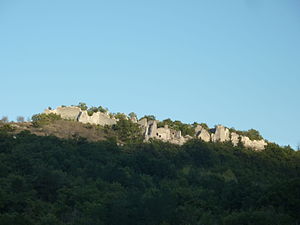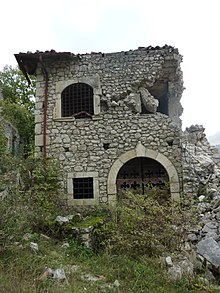Castello di Ocre
| Castello di Ocre | ||
|---|---|---|
|
Castello di Ocre |
||
| Creation time : | 12th Century | |
| Castle type : | Hilltop castle | |
| Conservation status: | ruin | |
| Construction: | Quarry stone | |
| Place: | Ocre | |
| Geographical location | 42 ° 17 '30.3 " N , 13 ° 28' 58.5" E | |
| Height: | 933 m slm | |
|
|
||
The Castello di Ocre is a fortified settlement at 933 m slm on Monte Circolo in the Italian municipality of Ocre in the province of L'Aquila . It is on the edge of the sinkhole that opens above the settlement of Fossa .
history
The first written mention of the Castello di Ocre can be found in the Catalogus Baronum , which names Todino di Collimento from the family of the Counts of Marsica as the feudal lord. A few years later it carried a bull from Pope Alexander III. from 1178 on the possessions of the Diocese of Forcana . In 1254 the Castello di Ocre was listed under the name "Cassari Castro" among those castles that were to be saved from destruction. This had been decided for all castles in the area in order to favor the foundation of the city of L'Aquila , because it belonged to the registrar of the judicial district of Gualtieri , heir of the Counts of Alba, who held the fief until the Norman conquest.
During the reign of Charles I of Naples in 1266, the castle fell to the Kingdom of Sicily . Also in 1266 the castle was sacked by the Aquileans after their city was rebuilt. This was previously destroyed by Manfred of Sicily with the help of the barons of the area. In addition, Charles I confiscated the castles of the Aquileans after they had assisted Conradin , and in 1269 they were entrusted with the Castello di Ocre Morel de Saours , sometimes referred to as Morello or Mauriello de Saurgio .
In 1283 the castle was transferred to Giovanni di Bissone and in 1293 it was sacked again by the Aquileans. The worst attack was to be that unleashed by the Condottiere Braccio da Montone in 1423 . When the castle had lost its role in the defense of the city of L'Aquila, it deteriorated noticeably: At the beginning of the 16th century, Ocre was no longer referred to as "Castrum", but as "Villa"; the population gradually left the fortified settlement.
description
The castle should actually be called a fortified settlement. Inside the walls you can still see the old houses, the tower houses and the streets.
The system has the shape of an isosceles triangle; its circumference is 470 meters; its base (i.e. the shortest side) is in the northwest, its tip in the southeast. Seven towers are built into the surrounding wall, three of them on the northwest side (two of them next to each other on the north side), one on the south side and another three mirrored on the center line of the curtain wall: two on the northwest side and one on the northeast flank, naturally protected by the overhang over the sinkhole of Fossa.
The only entrance to the castle is near the corner tower on the west flank and consists of a pointed arch gate from the 13th century, protected by a crossfire defense system.
At the meridian point is the church that is consecrated to the Most Holy Redeemer "inter castrum Ocre". It was built with three naves and an apse at the end and is now completely destroyed, even if it is mentioned in 1581. The remains of a fresco from the mid-12th century come from this church , depicting a Madonna and Child enthroned between two figures. This fresco is now in the Museo Nazionale d'Abruzzo .
Individual evidence
- ↑ Chiara Marcotulli: Chiese, castelli e strategie 'baronali'. Le trasformazioni del paesaggio medievale abruzzese fra feudalità signorile e città fondata alla luce della ricerca archeologica: un caso di studio . Ricerche Storiche. Rivista Quadrimestrale Anno XLI - No. 1.
- ^ Alfonso Forgione: I castelli di Ocre, Ariscola e San Vittorino (L'Aquila) . Academia.edu. Retrieved March 19, 2020.
swell
- Marialuce Latini: Guide ai Castelli d'Abruzzo . Carsa, Pescara 2000. ISBN 88-85854-87-7 . Pp. 57-59: Ocre (AQ): Il borgo fortificato .
- Enrico Santangelo: Castelli e tesori d'arte della Media Valle dell'Aterno . Carsa, Pescara 2002. ISBN 88-501-0051-5 . Pp. 66-66: Il Castello di Ocre .
Web links
- Castello di Ocre, Ocre . Cultura Italia. Retrieved March 19, 2020.
- Castello di Ocre . Abruzzo region. Retrieved March 19, 2020.
- Castello d'Ocre . Comune di Ocre. Archived from the original on October 16, 2014. Retrieved March 19, 2020.



